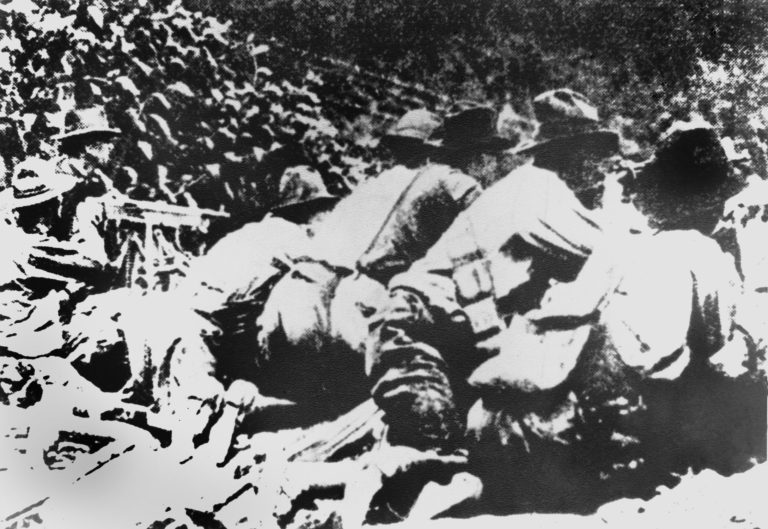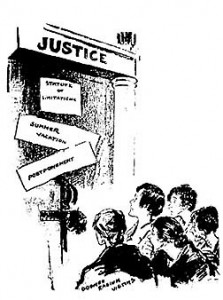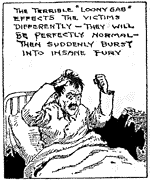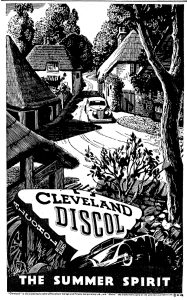
Coal company guards fire machine gun and rifles at rebelling miners, Aug. 1921, following Matewan assassination of sheriff and mayor by coal company guards.
1920- May 19 — Battle of Matewan takes place when coal mine guards attempt to evict miners from homes owned by a coal company in the town of Matewan, West Virginia. As the mine guards try to serve what mayor Cabell Testerman calls “bogus” eviction notices, a gun battle breaks out. The mayor and two deputies are killed, but sheriff Sid Hatfield and the other deputies kill seven of the mine guards. Hatfield becomes famous for standing up to the coal companies and faces several legal charges in the aftermath. Then, on Aug. August 1, 1921, Hatfield and a deputy are killed in retaliation by mine guards on the steps of a West Virginia county courthouse. None of the mine guards are charged with a crime, and by August, 1921, over ten thousand armed coal minters are in open revolt against the coal industry. The insurrection leads to Battle of Blair Mountain.
1920, June 10 — US Federal Power Act authorizes federal hydroelectric projects and begins a set of massive North American construction projects such as the Hoover Dam (pictured here, initially authorized in 1928).

Hoover Dam
1920 — US Mineral Leasing Act opens up rich deposits on federal lands for token rental fees.
1921 — US Supreme Court allows New Jersey to dump sewage into New York harbor in New York v. New Jersey and Passaic Valley Sewerage Commissioners. However, the court says:
The grave problem of sewage disposal presented by the large and growing populations living on the shores of New York Bay is one more likely to be wisely solved by cooperative study and by conference and mutual concession on the part of representatives of the States so vitally interested in it than by proceedings in any court however constituted. (Barros, 1974)
1921 — June 16 — Commerce Department holds conference to consider “the subject of water pollution and its relation to the fisheries.” Meanwhile, the Corps of Engineers begins an investigation of oil pollution in harbors. The discussion between state and federal officials and industry representatives “revealed a general failure of the states to cope with many important problems,” particularly oil waste, industrial waste and sewage that was threatening some varieties of migratory fish with extinction.
“There was indicated a practically unanimous demand on the part of the states for assistance from the federal government,” a conference report said. Oil discharge from tankers and refineries was “the most vital problem” affecting fisheries, the conference members said in a final resolution.
1921 — October — Thomas Midgley of General Motors demonstrates car powered by 30 percent alcohol-gasoline blend at Indianapolis SAE meeting.
1921, Dec. 9 — Leaded gasoline discovered — Thomas Midgley of General Motors discovers tetraethyl lead as an anti-knock gasoline additive. Despite strong private warnings about its danger,and a secret Public Health Service inquiry, the new gasoline goes on sale without safety tests 14 months after it was invented, with disasterous consequences. (See “loony gas” cartoon, above). 
The Radium Girls — 1922 — Amelia Maggia, first of the “radium girls,” dies of radiation poisoning. She was a dial painter with U.S. Radium Corporation in Orange, New Jersey. Many more would come down with radiation sickness and cancer in New Jersey, Connecticut and Illinois in the 1920s and 30s.
1922 — Laws restricting child labor are struck down as unconstitutional by the Supreme Court on the theory that such protective laws violate the Due Process clause of the Constitution and the theoretical freedom of every person to freely enter into contracts. Laws requiring workplace safety, employer compensation for injuries, manufacturer liability for products fall victim to the reactionary legal philosophy of the day.
1922, Summer — First harbor pollution survey — Corps of Engineers harbormasters respond to requests for reports on the condition of harbors:
- Glouster, Massachusetts — “A thick scum has caused serious damage to fish and sea life. It has also caused much discontent and complaint from tourists.”
- Charleston, South Carolina — “Local fishermen complain of injury to fishing and say fish have been driven away from harbor and inlets…”
- New Orleans, Louisiana — “A considerable proportion of the batteries are noticeably polluted with oil. No beach can be considered suitable for recreation. A disastrous fire occurred in the port a year ago, the fire to a considerable extent being spread by oil pollution.”
- Portland, Oregon — “Considerable damage has resulted [from oil spills], especially to floating logs and sawed timbers…”
- Baltimore, Maryland — “There has been a very detrimental effect on fish, oysters and wildfowl.”
1922 , August 10 — National Coast Anti Pollution League formed by state and municipal officials at Atlantic City, New Jersey to stop oil dumping. Elected as president is Gifford Pinchot, also now running for governor of Pennsylvania and formerly Teddy Roosevelt¹s leading conservation expert. Pinchot wins the governorship in November. President David Neuberger writes in the New York Times:
“About twenty miles below Sandy Hook (NJ) one is greeted by four miles of … oil, sludge, tar and bilge water resting on the ocean. It is steadily increasing and defiles everything it touches… The question presents itself: Shall industrial waste be held superior to the public weal, public health, sanitation and the conservation of food? Shall this sort of industiral progress be permitted at the expense of our people, and shall all these be made subservient to industrial waste? It was to overcome these conditions by drastic laws and their enforcement, compelling ship owners to find a method by which all these ills might be alleviated, and the owners of industrial plants shown the way to cooperate, that this League was organized. There are methods which, if properly applied, would stay the menace and avert the consequences.”
1922 — August 15 — In support of the National Coast Anti-Pollution League, a columnist in the Philadelphia Ledger newspaper writes of a time, 20 years beforehand, when fish were common in the Delaware River:
“How [can] any sane person deliberately go into such black and vile-looking water? … [Only twenty years ago] the haul of the shad net brings that thrilling moment when the encircled fish break water and the whole surface inclosed in the arc of bobbing corks suddenly bursts into silver flame as a hundred fine big fellows leap and churn in a last desperate effort … There’s a lot more than sentiment in such reminiscences as these… They mean happiness and health in an age when the tendency is to sleep away from the turmoil and the ‘twice breathed air’ of the city… The lack of such things means millions of dollars in good, hard cash, to say nothing of the less material considerations. Philadelphia, of all cities, should support the Anti-Pollution League and should welcome the election of Gifford Pinchot to its presidency.”
1922 — League of Nations bans white-lead interior paint but the US declines to adopt the ban.
1923 — Feb. 2 — Leaded gasoline goes on sale in Dayton, Ohio without safety tests and despite protests of public health experts.
1923 — Izaak Walton League founded, fights Mississippi valley dredging project with Washington, D.C., lobbying effort.
1923 — Harry Ricardo publishes The High Speed Internal Combustion Engine (London: Blackie & Son, Ltd.). As one of the most accomplished automotive engineers of the 20th century, later inventor of the Rolls Royce Merlin engine that powered the Spitfire, Ricardo is one of the world’s leading authorities on engines and fuels. In his book, he states:
“…It is a matter of absolute necessity to find an alternative fuel. Fortunately, such a fuel is in sight in the form of alcohol; this is a vegetable product whose consumption involves no drain on the world’s storage and which, in tropical countries at all events, can ultimately be produced in quantities sufficient to meet the world’s demand, at all events at the present rate of consumption. By the use of a fuel derived from vegetation, mankind is adapting the sun’s heat to the development of motive power, as it becomes available from day to day; by using mineral fuels, he is consuming a legacy – and a limited legacy at that – of heat stored away many thousands of years ago. In the one case he is, as it were, living within his income, in the other he is squandering his capital… “
1924, June 7 — Oil Pollution Act finally passed in weakened form, prohibiting discharge from any vessel within the three-mile limit, except by accident. A stronger act would have prohibited discharges from oil refineries. Commerce Secretary Herbert Hoover fumes:
“Official Washington has no knowledge that the American people give a damn about pollution, and until they do care, there will be no great advance as to pollution.” (Drake, 1973).
 1924 — Oct. 24 — Five refinery workers die “violently insane” at Standard Oil (Exxon) refinery making tetraethyl lead gasoline additive in grossly unsafe conditions. News surfaces that seven other workers died previously at G.M. and DuPont plants. New York and other cities and states ban leaded gasoline. In all, 17 workers would die in the 1924 — 1925 period.
1924 — Oct. 24 — Five refinery workers die “violently insane” at Standard Oil (Exxon) refinery making tetraethyl lead gasoline additive in grossly unsafe conditions. News surfaces that seven other workers died previously at G.M. and DuPont plants. New York and other cities and states ban leaded gasoline. In all, 17 workers would die in the 1924 — 1925 period.
1924 — Teapot Dome oil leasing scandal breaks out in which the Interior Dept. secretary, Albert Fall, is discovered to have taken loans from companies that were given leases to government oil fields.
1925 – Feb. 22 –Frances Splettstocher becomes the first of the Waterbury Connecticut radium workers to die of cancer. Not much is known about the Waterbury radium dial painters, who had no newspaper coverage and no state board of health investigations, unlike the Orange, New Jersey and Ottawa, Illinois dial painters. But from 1926 to 1936 the Waterbury Clock Company spent almost $90,000 on settlements, support and medical costs for 16 women.
1925 — May 10 — Commerce Secretary Herbert Hoover receives but does not publicize a report concerning alternatives to leaded gasoline then being used in 25 foreign countries.
1925 — May 25 — Surgeon General holds a conference on leaded gasoline. Ethyl officials claim it is a “Gift of God” and no alternatives are possible. But the investigation of alternatives is sidetracked, much to the dismay of Harvard professor Alice Hamilton and other public health crusaders.
 1925 — Sept. 3 — Crash of the US Airship Shenandoah in Ohio. The cause of the crash, according to the British Engineering magazine, was the use of Ethyl leaded gasoline which caused engine failure. US board of inquiry ignores the issue. Memos at GM and Ethyl, released in 1992, reveal Ethyl management alarm at the time and confirmation that Ethyl was being used in the Shenandoah.
1925 — Sept. 3 — Crash of the US Airship Shenandoah in Ohio. The cause of the crash, according to the British Engineering magazine, was the use of Ethyl leaded gasoline which caused engine failure. US board of inquiry ignores the issue. Memos at GM and Ethyl, released in 1992, reveal Ethyl management alarm at the time and confirmation that Ethyl was being used in the Shenandoah.
1925 — Sept 14 – Charter for a 500,000 horsepower hydroelectric tidal barrage approved for Passamaquoddy Bay, Maine. (New York Times, Sept. 14, 1925.)
1925 — Sept. 28 – A group of businessmen protested pollution of beaches with oil, garbage and refuse. (New York Times, Sept. 28, 1925, p. 15)
1925 — The Boys Book of Science is published, complete with instructions about building x-ray machines so that “you can see the bones in your hand.” Yet 21 years beforehand, an assistant for Thomas Edison, Clarence Dally, died from exposure to x-rays. Such is the state of the precautionary principle in the day, that even a boys book of science fails to take the deadly nature of x-rays into account when encouraging boys to go into scientific fields.
1926 — January — Surgeon General’s committee of experts on leaded gasoline reluctantly permit Ethyl to return to the fuel market. Strong recommendations for further research are never funded. Public Health experts cry foul, but leaded gasoline stays on the market until 1986. Signs in some gas stations say “Ethyl is back.” Signs on other gas stations say “Ours never had to leave town.” By 1932, trade disparagement laws would be used to stifle such comments.
1926 — First large scale survey of air pollution in U.S., in Salt Lake City.
1926 — Public Health Act (UK) expands Alkali Acts of 1863 and 1906 to control any chemical process considered to cause serious pollution. A public inquiry is to be held before each extension and the authority of an order laid before Parliament for any extension. Also extended in 1958. (Hunter, 1955).
1927 — River and Harbor Act gives Corps of Engineers task of surveying and planning navigation system for inland waters. Previously federal money had been spent primarily on harbor improvements.
1927 — Five New Jersey women, called “The Radium Girls,” file lawsuits against their former employer the U.S. Radium Corp. for negligence in creating dangerous working conditions. All five died of radiation induced cancer within a few years after the suit was settled in 1928.
1927 –January 29 — Edward Abbey born in Indiana, Pennsylvania. Abbey was the author of 21 books, including The Monkey Wrench Gang — a semi-comic book about environmental activism. He died in March 1989
1928 — March 12 — St. Francis Dam gives way in Los Angeles, killing over 500. The dam was built as part of the controversial Owens Valley water project by William Mulholland, chief engineer of the city’s water department. The breakup of the dam is today considered to be an example of what can happen if the principles of engineering geology are not well understood or overlooked. Improved safety measures were required in the aftermath of the disaster, including federal safety reviews based on uniform geological surveys.
1928 — June — Radium lawsuits settled out of court after campaign by Walter Lippmann of Pulitzer¹s New York World newspaper.
1928 — Public Health Service begins checking air pollution in eastern US cities, reporting sunlight cut by 20 to 50 percent in New York city.
1929 — Over 100 wildlife sanctuaries consolidated under federal protection by Norbeck-Anderson Act.

